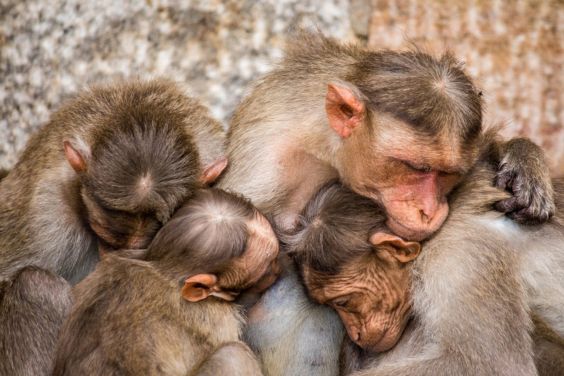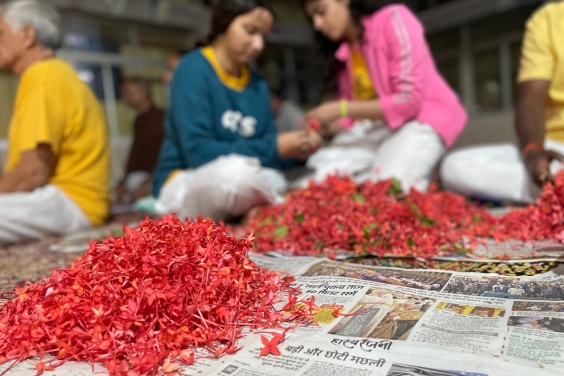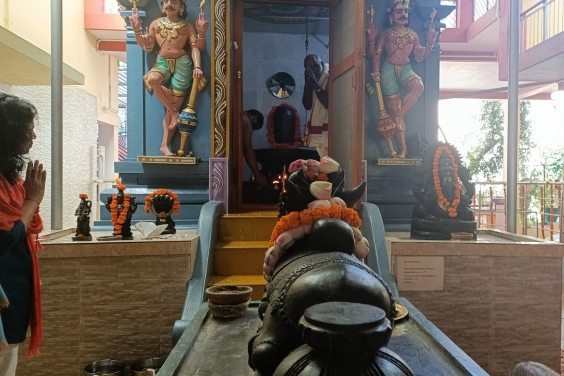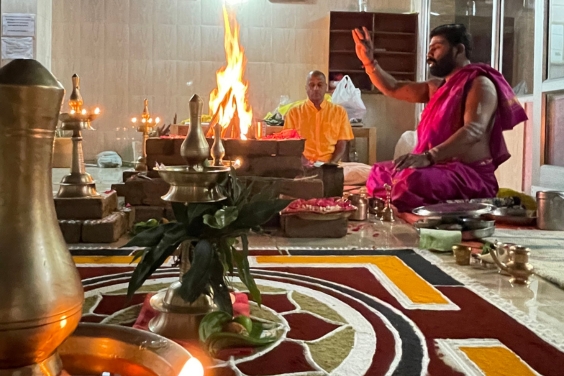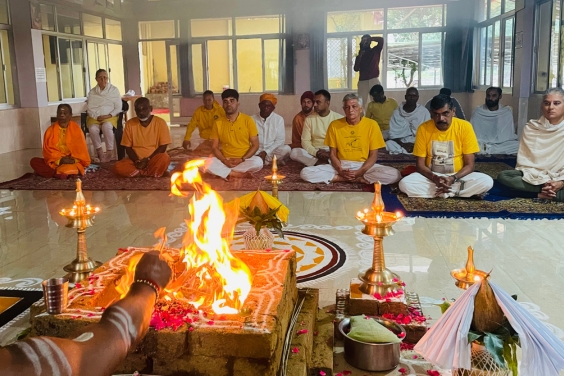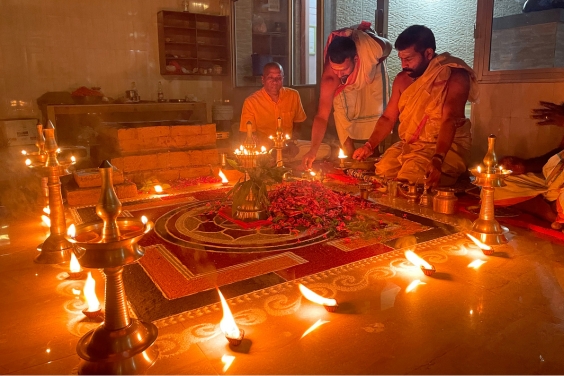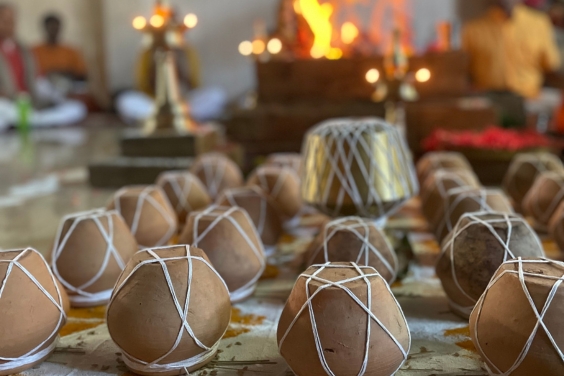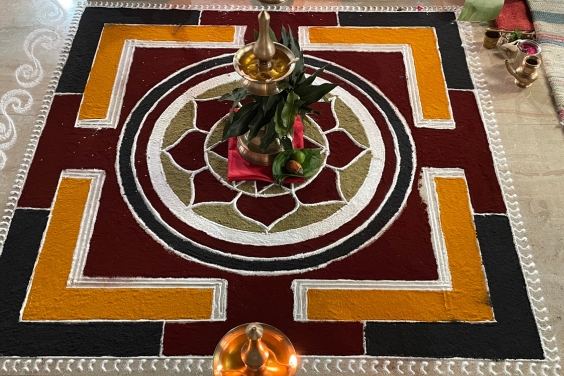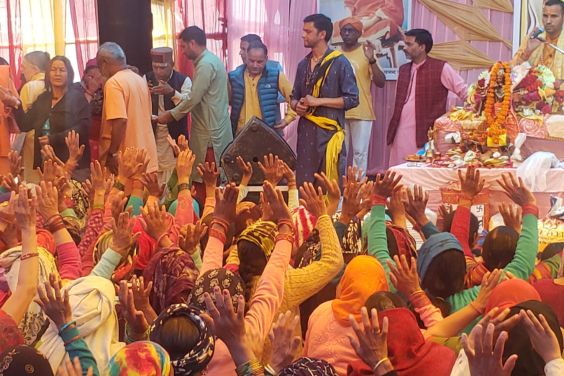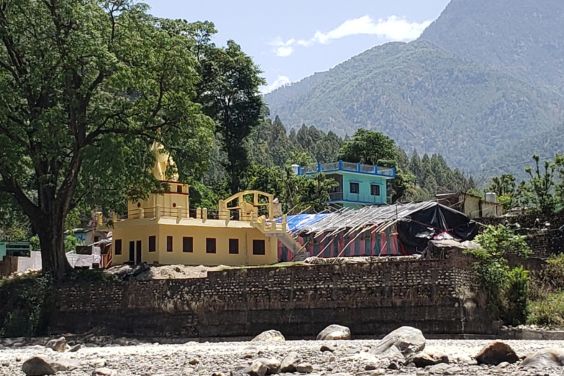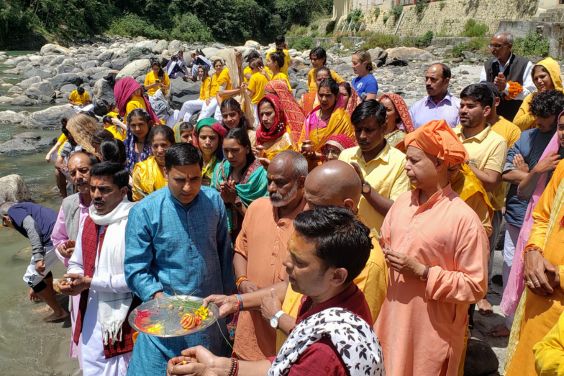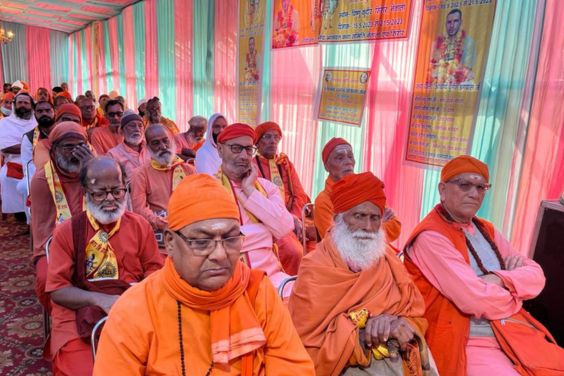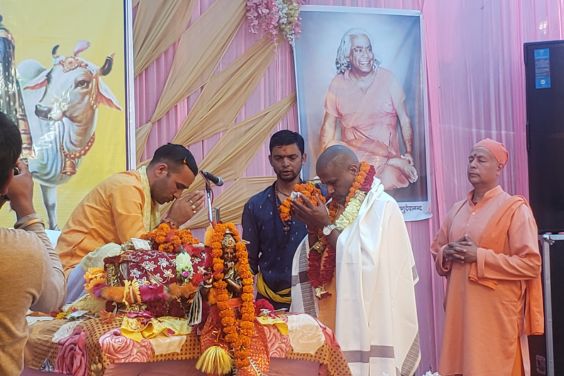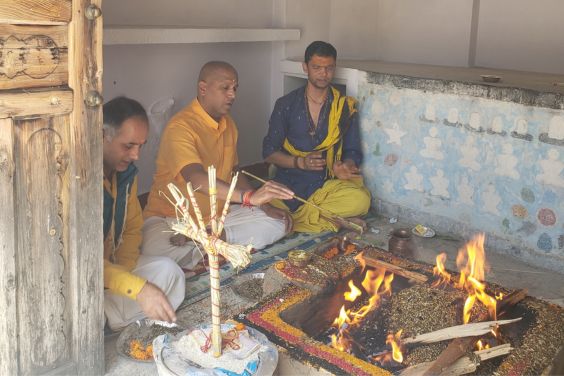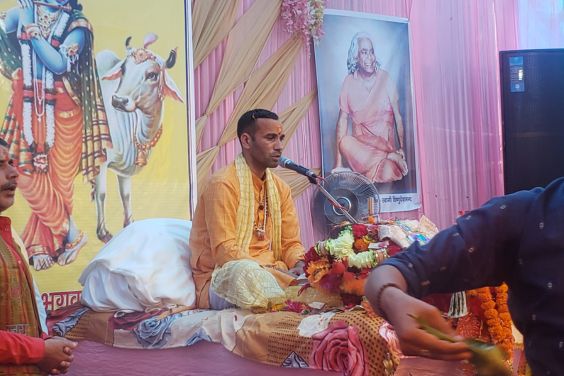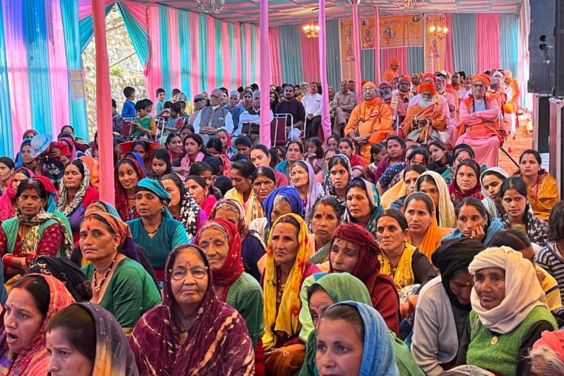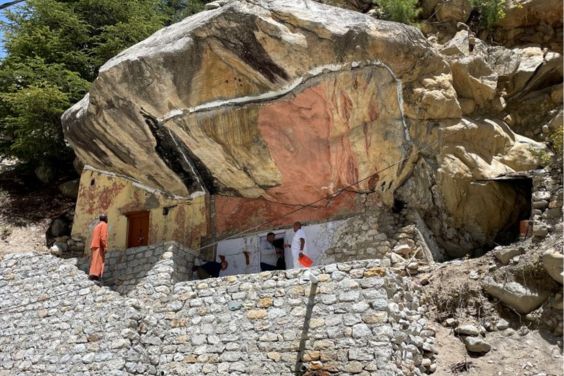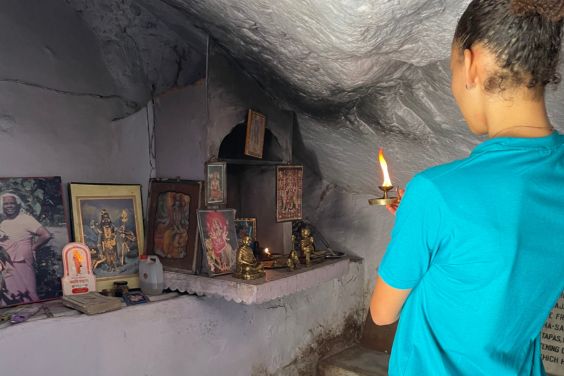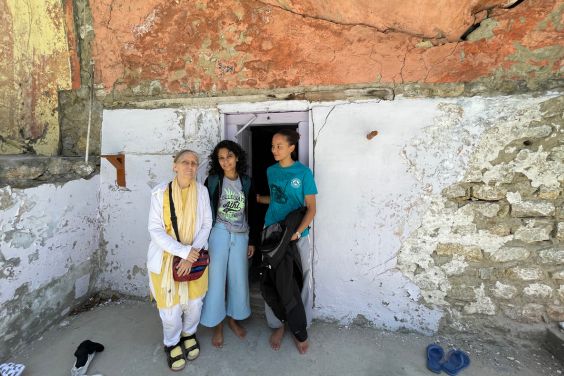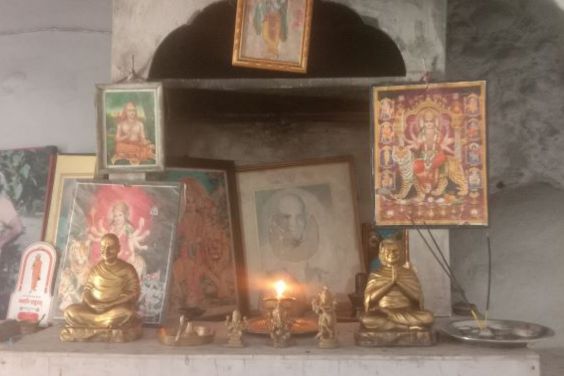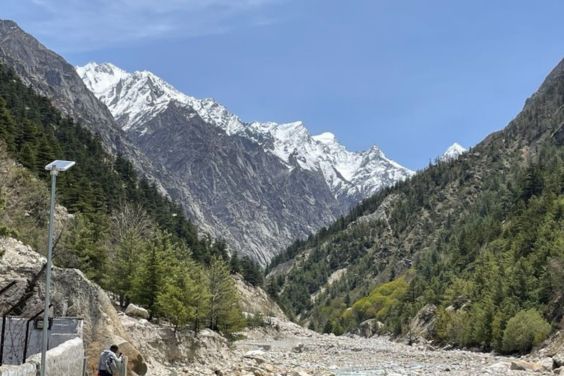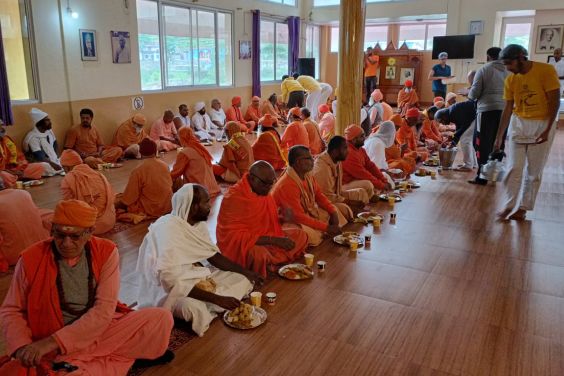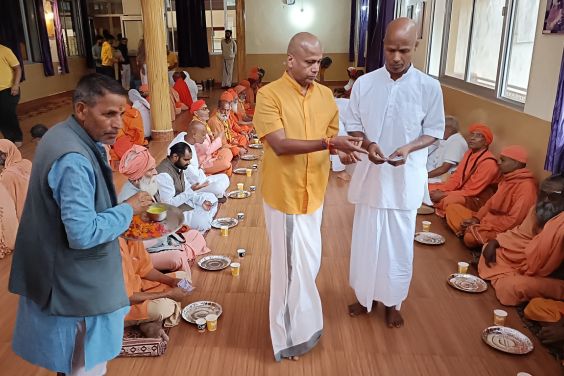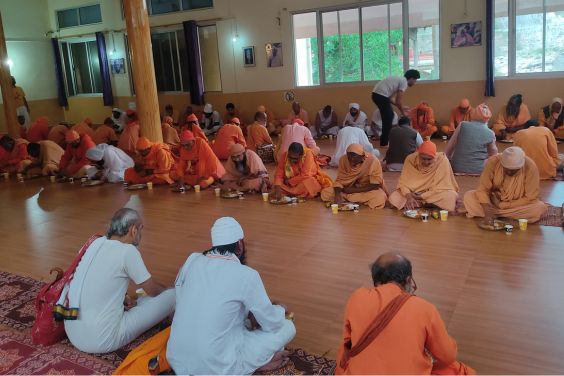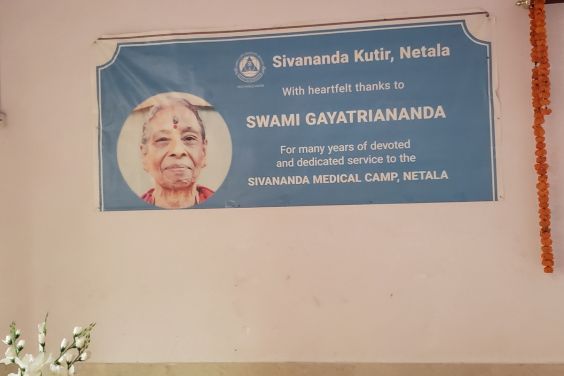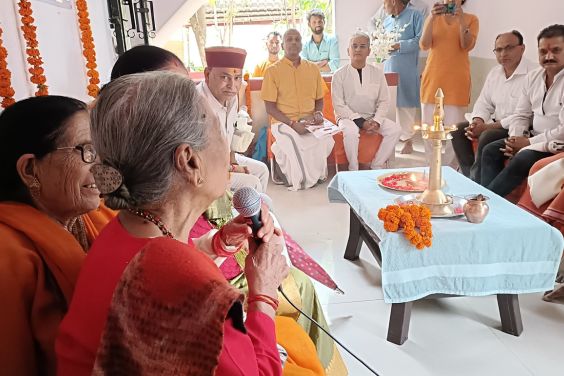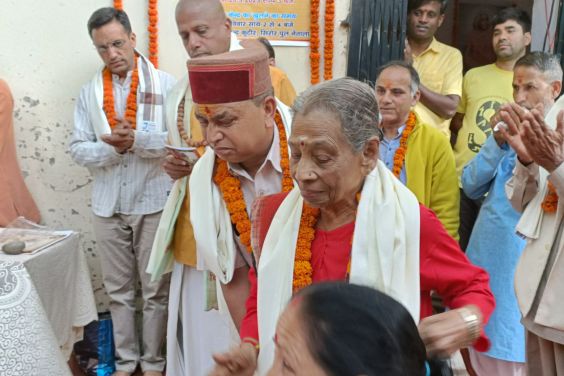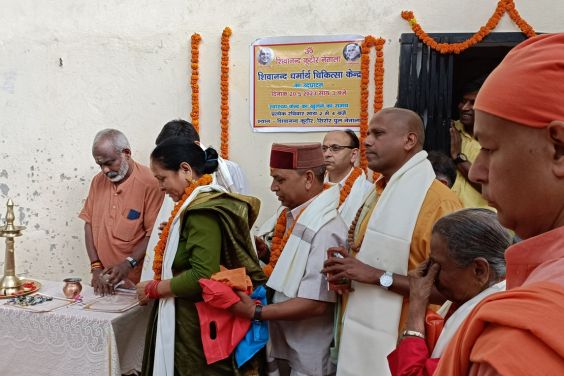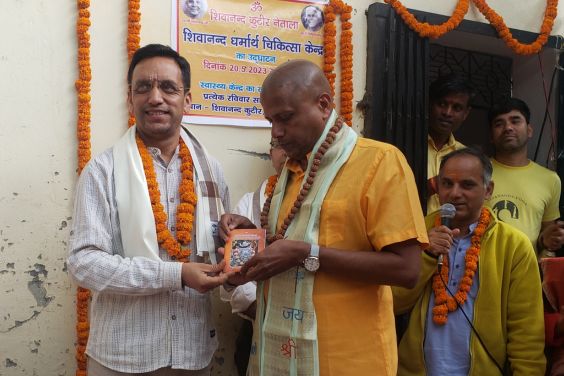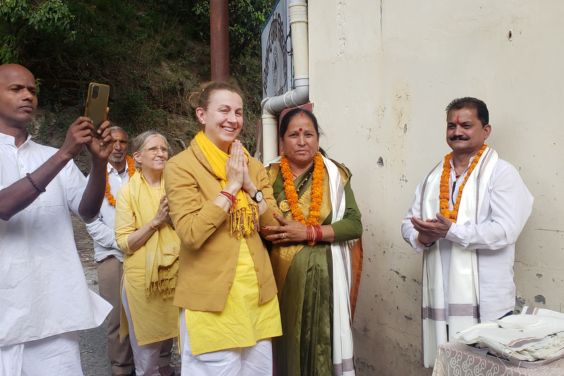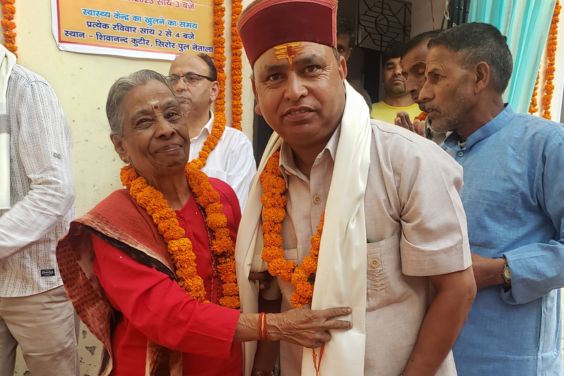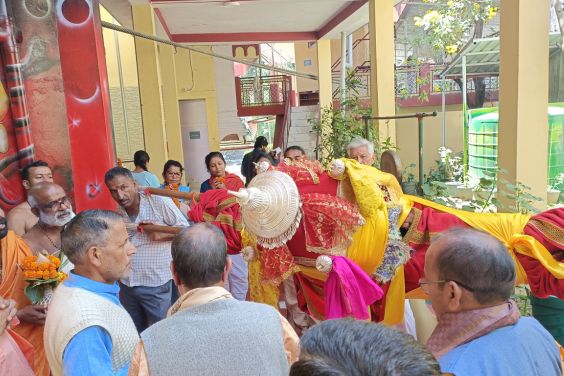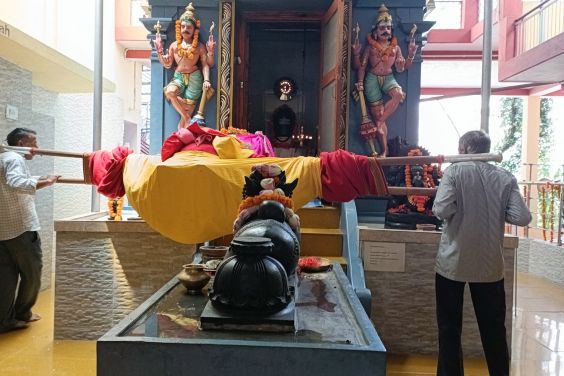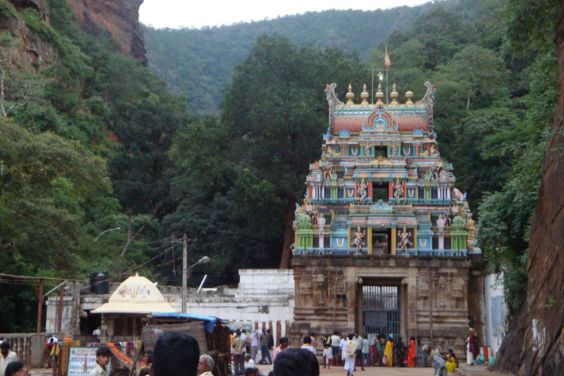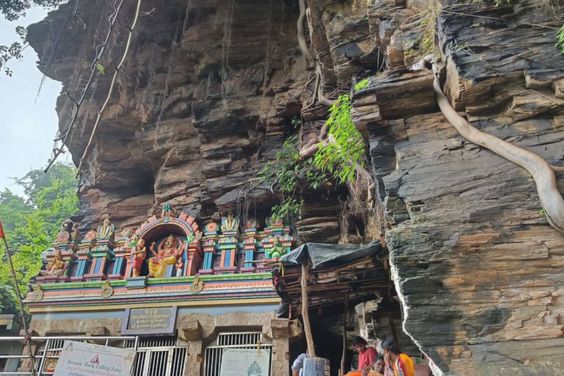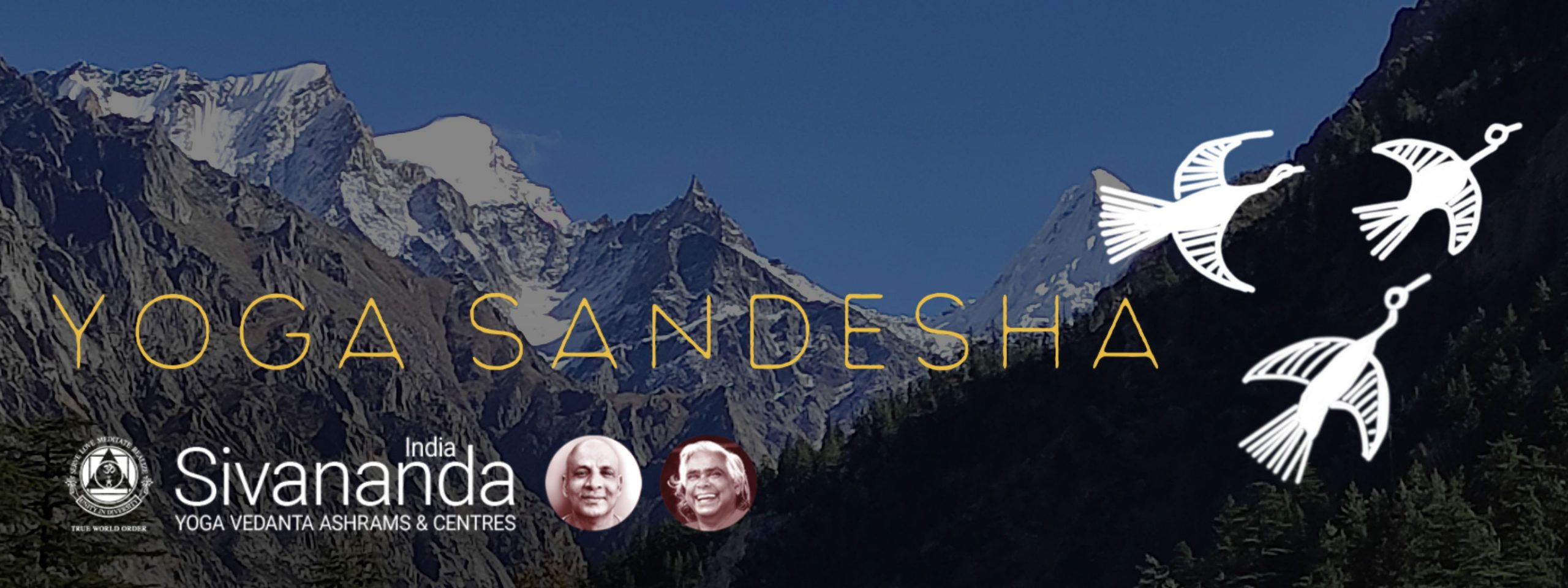
June 2023 | Family
Om Namah Sivaya
Blessed Self,
Swami Vishnudevanandaji’s vision was to create spiritual homes that could be used by seekers and sadhakas for many years into the future. This pure thought led him to create the many Sivananda ashrams and centres around the world. Swamiji would recognise what people of all walks of life needed, and, without compromising the scriptural teachings, make them simple and easy to integrate into daily life. Swamiji truly believed in the importance of the Yoga Vacation programme to enrich its practitioners and instil the needed discipline to live in a more peaceful way.
Back in 1991 Swamiji requested that the Yoga Vacation, Teachers’ Training Course, Advanced Teachers’ Training Course, and Sadhana Intensive course be conducted at the then tiny Netala ashram in Uttarkashi, Uttarakhand. At that time the senior disciples did not fully understand Swamiji’s vision. Over the years that vision was partly realised in 2003 with the first Teachers’ Training Course, and, subsequently the Advanced Teachers’ Training and Sadhana Intensive Courses. Due to a lack of accommodation the Netala Ashram couldn’t be expanded further. Over the course of the pandemic we were able to add additional beds and finally realise Swamiji’s vision of bringing Yoga Vacationers to the Sivananda Kutir, Netala, Uttarkashi. Due to its proximity to the pure Ganges and high elevated Himalayas, many students wanted to go there but were unable to due to the TTC courses running. Now that we have added Yoga Vacation, the ashram is completely full and students are extremely happy. We are grateful to Master and Swamiji for bringing their teachings to many on the banks of the Ganges.
The Netala Ashram is now welcoming all and has developed a good rapport with the local community. The recently conducted Bhagavata Saptaha was enjoyed by over 200 villagers on average, each of the seven days. We are also blessed to celebrate the Akhandeshwar (Lord Siva) Temple Anniversary in the ashram at the same time. Pujas were led by a dedicated team of priests brought from Kerala, Swamiji’s birth state.
Swamiji believed in the power of spiritual events and festivities like these to bring people together. This was evident with both the villages of Siror and Netala coming together to participate in all the events along with the International crowd of Teachers’ Trainees present at the ashram along with the VIP’s and well-wishers that came especially for these events.
We are truly inspired to see the response from the public with Master and Swamiji’s teachings in all our ashrams and centres, as many take refuge in these teachings after the pandemic, and the guest numbers slowly pick up.
As staff we are humbled to see the effectiveness of Swamiji’s teachings, providing motivation for our own practice and cementing our belief in the pure teachings as taught by Swamiji and Master Sivananda.
Pranams to all,
Sivananda Yoga Vedanta Ashrams & Centres, India
By definition a family is a group of persons related by birth, marriage, or adoption who live together. However, those of us living in ashrams or spiritual communities know that a family can also be of our choosing, people brought together by practice, or shared interests who wish to support one another to move forward on the spiritual path. This month we focus on some different perspectives on family: sharing Swami Sivananda’s words about the Four Asramas, or stages of life, living alone as a woman in Indian society, as well as some specific practice tips for women. We also share news from our ashram in Netala, Himalayas, a family-friendly recipe for pumpkin soup, and a focus on the adventure and spirituality of the Narasimha Temple in Ahobilam, a few hours’ drive from our Gudur Ashram in Andhra Pradesh.
We hope you enjoy the newsletter. As usual, please feel free to reach out to us with your thoughts and feedback: [email protected]
News Item: Ashram Activities Sivananda Kutir, Netala, Uttarkashi, Uttarakhand
It’s been a busy month in the Himalayas at the Sivananda Kutir, Netala. This month we saw the commencement of the Yoga Vacation programme at the ashram, the start of a Teachers’ Training Course, as well as the eighth anniversary of the Akhandeshwar (Lord Siva) Temple, the reopening of The Sivananda Kutir Free Medical Clinic, a Special Bandhara for local sadhus and sannyasins, and a Bhagavata Saptaha programme arranged for Netala and Siror village residents and held in the Vishnu Kutir, in Siror village on the other side of the Ganga, across from the Ashram. We also had a visit from the Gramadevata, the local deity for Netala village. Several of our Trustees and other VIPs were present for these programmes. Please find photos below. We hope you enjoy the photos and feel a part of our community and activities here.
Photo Update: Akhandeshwar (Lord Siva) Temple Anniversary Pujas, Netala
Over three days several pujas were conducted with three visiting priests from Kerala. The pujas were attended by students and guests, trustees, VIPs, and senior staff from across India.
Photo Update: Bhagavata Saptaha, Vishnu Kutir, Siror Village
Bhagavata Saptaha is a seven-day series of lectures on the Srimad Bhagavatam, an explanation of the Brhma-sutra and Mahabharata, thought to illuminate all of Vedic literature.
Photo Update: Visit to Sivananda Guha (Cave), Gangotri
Several of our senior staff, VIPs, and karma yogis made a pilgrimage to Swamiji’s cave in Gangotri. Sitting inside the cave you feel as if you are within the earth itself. Together with the walk from Gangotri to the cave, passing many such caves gives you a taste of the life and commitment of those who quietly practice and live in such caves.
Photo Update: Special Bhandara, Sivananda Kutir, Netala
A Bhandara is an occasion where sadhus are honoured and fed, commemorating the tradition of the sadhu way of life. Sivananda Kutir conducted a special bhandara in conjunction with the Akhandeshwar (Lord Siva) Temple Anniversary. Over 50 sadhus and sannyasins attended the event.
Photo Update: Reopening of The Sivananda Kutir Free Medical Clinic, Netala
After several years of inactivity, the Sivananda Kutir Free Medical Clinic was reopened with local dignitaries and ashram inmates in attendance. The community applauded the reopening of the clinic which serves the local community with free medicines and medical consultation each Sunday.
Photo Update: Visit from Gramadevata, Sivananda Kutir, Netala
A Gramadevata is a local deity, in this case from Netala Village. The Gramadevata visited the Ashram, carried on a palanquin and gave blessings in the Akhandeshwar (Lord Siva) Temple.
Research/Links
- An abstract for a study being undertaken of how practicing yoga as a family strengthens caregiver/child relationships and enhances self-esteem:
https://albertaacademicreview.com/index.php/aar/article/view/100 - New research shows that daily slow-breathing exercises may lower the risk for Alzheimer’s disease. Sounds like pranayama! Read more here:
https://www.alzforum.org/news/research-news/take-deep-breath-it-just-might-lower-your-risk-alzheimers
Spiritual Calendar
June 4 – Full Moon
June 14 – Ekadasi
June 18 – New Moon
June 29 – Ekadasi
Upcoming Courses:
Learn, Practise & Grow with Us!
Teachers’ Training Course (TTC)
June 18 to July 15, Netala, Himalayas
July 23 to August 19, Netala, Himalayas
August 13 to September 9, Neyyar Dam, Kerala
September 10 to October 7, Netala, Himalayas
For more details, click here
ONLINE Adapted Sivananda Yoga Course (ASYC)
July 23 to 30, 2023 on Zoom
For more details, click here
Courses in Thailand this fall at the Phu Chaisai Mountain Resort in Chiang Rai
Sadhana Intensive, September 16 to 30, 2023
Teachers’ Training Course, October 1 to 28, 2023
Advanced Teachers’ Training Course, October 1 to 28, 2023
Yoga Vacation, October 7 to 11 and October 21 to 25, 2023
For more details, click here
Teachings Excerpt:
The Four Asramas or Stages of Life by Swami Sivananda

In our grand Indian culture they conceived of life in four stages: the preliminary stage, the development stage, the flowering or blossoming stage, and the culminating fruitful stage. The satisfactory growth of the latter three stages truly depends upon the management of the first stage.
The First Stage: Student or Brahmacharya – The supreme value of the student period is incalculable. Student life is the most precious life. The way in which you utilise this period will decide the nature of the coming years that lie ahead of you. Your happiness, your success, your honour and your good name all depend upon the way in which you live now. In this present period, you are preparing your future. Remember this. I wish you to be great. The world has put its faith in you. Your elders keep their hope upon you. Now is the time for you to wisely mould your life, your character, your physical health, and your entire nature. It is like the laying of the foundation for an important building you wish to construct. If this building is something very important to you, then just think how much more important its proper foundation becomes in your view.
The strong and continued existence of the building depends certainly upon the foundation. This is the stage you are now in. Let your preparations be wise, correct, and of such a kind that will lead to your true welfare, supreme good, and lasting happiness. You should acquire knowledge not only of History, Geography, Mathematics, etc., but also about human nature, the science of self-control, the art of developing a pure mind, the duties of men and women, and the proper relationship between you, the world, and God. Thus, the first 25 years of human life should be dedicated to acquiring good health, perfect character, self-control, and all that is necessary for you to know in order to live life righteously, to be financially independent via some trade or profession, and to thus attain lasting satisfaction and happiness.
The Second Stage: Married Life or Grihastha – Having already created a firm and ideal foundation, the student enters into the second stage of life, the householder’s life. One is not merely entering into a physical partnership with another physical creature, is not entering into a social relationship with another family, but is entering into a spiritual partnership with another soul in order to fulfil a mutually shared divine destiny, so that the relationship between husband and wife is essentially a spiritual partnership between two souls. Your spouse is to you everything: companion, friend, consoler, helper, and partner in this great spiritual adventure. Such is the ideal and total concept of this relationship. With such an understanding, the home becomes not only a place for living the normal worldly existence, but also a place of worship and devotion. Daily worship, helping those in need, and honouring the guest (especially the chance visitor who happens to be at your door at the time of food) become primary duties of householders. Another aspect of the householders’ duty is to evolve between themselves reciprocally a certain ideal behaviour of mutual love, honouring each other’s individual freedom. Such an atmosphere becomes the ideal ground for nurturing the new generation. The children find that between their parents exists a beautiful relationship of harmony, love, mutual respect ,and tolerance, which creates an ideal atmosphere for their growth. Through their personal relationship the parents place before the children an exemplary way of conducting themselves which becomes the first educational process of the child. Home is, therefore, the nursery of the nation, nursery of the world. Providing an ideal setting and an ideal atmosphere for the generation of tomorrow is an important duty of the married couple.
The Third Stage: Retirement or Vanaprastha – Having fulfilled the duties of raising children, making them adults capable of standing on their own feet, a new stage of life comes into being. Up till now you were entirely preoccupied with your family and your profession, providing for your parents, wife, children, and other dependants. To a certain extent, it was a self-centred life, although one practised selflessness for the sake of the children and family. But now one must give way to the new generation. Having retired, with a little more leisure on your hands, and with a vast reservoir of professional experience and expertise, one has the time to become true selfless servants of the society, to become altruists and philanthropists. This is also the time for husband and wife, together, to enter more into the inner life, study, meditation, prayer, pilgrimage. We must realise that a time comes when we have to say “Good-bye”. We have to prepare for that last journey.
The Fourth Stage: Renunciation or Sannyas – At this time of life the only duty is to gather together one’s mind and place it upon the Supreme Being. That is the fourth quarter of life, the sunset period of one’s life, when all your relationships and connections are coming to a close. At this time, your entire mind should be fixed upon the Eternal, no more on the passing world. You have fulfilled all your duties, and now you have to depart. The river is reaching the ocean, and a time will come when it has to merge into the ocean.
Here one’s mind has become calm, steady, and pure. One’s heart is desireless and free from all cravings. One is established in perfect self-restraint and virtue. This ideal state is the fruit of right living. Here, one automatically becomes absorbed in the contemplation of the Supreme and moves towards God-experience. He or she reaps the harvest of a rich inner spiritual life, supreme peace and bliss, obtaining that ultimate objective for which one has taken birth. That is the goal to be reached.
Teaching & Practice Tips:
Areas of Focus for Women in Hatha Yoga
We are living in a conscious era where women want to focus equally on all aspects of their life. Women today seek balance in diet, exercise, career, relationships, travel, health, and selfcare. Over the last few years there has been a surge of interest in women’s health and reproductive health, and many women have adopted a yogic lifestyle as an important part of their body and mind selfcare. While this is a positive trend, two areas are often overlooked:
- Hormonal Health
- Pelvic Floor Health

Hormonal Health: Our entire physiology functions on the signalling of hormones. It is therefore not surprising that hormonal health can make a women feel at the peak of health or at the bottom. Hormonal health is at the centre of femininity, and the balance of hormones like estrogen, progesterone, cortisol, adrenaline, and testosterone are vital to women’s health. The following yoga asanas are very helpful in supporting women’s hormonal health:
- Sun Salutation (Surya Namaskar) helps by improving circulatory health and increasing the flow of oxygen and prana in the body. This helps supply all body organs with ample blood supply to thrive and flourish.
- Cobra (Bhujangasana) helps stimulate and strengthen the adrenal glands and kidneys for optimal function of adrenalin.
- Reclined Butterfly (Supta Baddha Konasana) helps to create opening in the pelvis and improve the flow of blood to the reproductive organs.
- Bridge (Setubandhasana) helps to create stimulation and strengthening in the pelvis and reproductive organs.
- Garland (Malasana): A great posture for the pelvis and reproductive organs, the sites of production of estrogen and progesterone.
Your pelvic floor health matters because all reproductive organs are encased in the pelvic cavity. Lack of flexibility in the pelvis can deeply impact the reproductive health of a woman. The reproductive organs include the bowels, bladder, as well as related muscles and ligaments. The following yogic practices help support pelvic health:
- Mulabandha (an internal lock typically practiced during advanced pranayama) helps strengthen the muscles related to reproductive health. The connecting muscles are pulled up in order to strengthen and improve blood supply to the reproductive organs.
- Utkatasana (Chair Pose) helps strengthen the pelvic floor. In chair pose, the pelvic floor is stretched when going down, and lifted when coming up.
- Variations of Trikonasana and Sirangushtasana in a lunge help to lift the perineum and supports Mulabandha, the perineal lock.
- Locust pose (Salabhasana) helps create a counterbalance for pelvic floor support by working on the gluteal muscles.
Temple Showcase:
Ahobilam Temples, Andhra Pradesh
Ahobilam is a sacred place in Andhra Pradesh known for its Lord Narsimha temples. Surrounded by the Eastern Ghats range, the Ahobilam houses temples where the nine forms of Lord Narasimha are worshipped. Narasimha is the lion-headed avatar of Lord Vishnu. The place holds a religious relevance and the legend tells that Lord Narasimha Swamy killed the demon Hiranyakasipu in order to safeguard life of his devotee Prahalada. Ahobilam got its name from the act of strength that Lord Narasimha demonstrated to kill the demon. Ahobala means great strength. Another legend states Ahobilam means ‘wonderful cave’, referring to a cave where Garuda meditated for the blessings of Lord Narasimha. A popular belief is that the nine planets inherit their power from the worship of these nine forms of lord Narasimha. It is also believed that the ill effects of planetary influence can be overcome by worshiping lord Narasimha’s nine forms. Ahobilam has nine shrines dedicated to these forms of Lord Narasimha Swamy. These are divided into “Upper” and “Lower” Ahobilam. Upper Ahobilam is about ten kilometres trek from Lower Ahobilam and houses the following temples:
- Ahobila Narasimha: The oldest and main temple of Ahobilam, known as Ugra Narasimha, is reached by a heavenly trek through the dense forest. It is believed that the Lord appears in his self-manifest and fierce aspect in this temple where the Lord is seen tearing the chest of demon Hiranyakashipu apart.
- Krodha Narasimha: With face of a boar, Sri Krodha Narasimha is also known as Varaha Narasimha. To reach this temple, you trek from Ahobilam Narasimha Temple towards the banks of Bhavanashini River.
- Jwala Narasimha: The mesmerising sight of the idol in Jwala temple makes it worth visiting. Here, Lord Narasimha can be seen with 8 arms, 2 of which hold Hiranyakashyapu on his lap, 2 arms tearing the chest, 2 arms wearing the intestine as a garland, and the remaining two arms holding Shankh and Chakra (conch and wheel).
- Malola Narasimha: This temple sits a few stairs up from the Kroda Narasimha temple. The diety here has a peaceful composure with an idol of mother Lakshmi sitting beside Narasimha, symbolizing motherly love.
Between Upper and Lower Ahobilam lies the Sri Karanja Narasimha temple. Lower Ahobilam houses the following Narasimha temples:
- Sri Yogananda Narasimha: This is Narasimha’s form in a yogic posture with crossed legs (Padmasana). The legend tells that Lord Brahma attained peace of mind here by worshipping Lord Narasimha and practicing Yoga.
- Chatravatha Narasimha: This deity is the most mesmerizing of all 9, as the tallest and most handsome Narasimha with a beautiful smile. The legend tells that two Gandharvas mesmerized Lord Narasimha with their divine music, and thus the temple environment is lively with devotee performances with music.
- Pavana Narasimha: This temple is located on the banks of the River Pavana, deep inside the Ahobilam forest. This temple is to liberate devotees from past and present sins.
- Bhargava Narasimha: This temple is located deep inside Ahobilam. The temple gets its name from Bhargava Rama (Lord Parashurama) who pleased Lord Narasimha by performing penance. This form of Narasimha is considered the most aggressive form of Lord Narasimha.
Ahobilam is four to five hours’ drive away from our Ashram in Gudur. It is well-worth a visit both for temple pilgrims as well as those who enjoy adventure and trekking. Ahobilam was very dear to Swami Vishnudevananda who referred to it as the “Original Temple of Lord Narasimha” and he visited here in 1992, just before he left his physical body. The staff had been calling Swamiji “Narasimha” because of the long beard he wore at the time!
Book Review: Table for One by Sumaa Tekur
One of the most common questions we get asked by students and also TTC graduates here in India is how to find balance between sadhana or spiritual practice and the responsibilities of family life. Although many women take up the practice of yoga, we don’t see too many examples of women choosing to live solo. In her book Table for One, TTC Graduate Sumaa Tekur explores aspects of solo living for women in Indian society. The book shares perspectives on various aspects of women’s lives, including societal expectations, spiritual life, freedom, and solitude. Another of our TTC graduates, Vishal Sharma, provides his thoughts on Table for One:
In India, we don’t really know how to deal with living alone. We see it as a sad, depressing, social status. Sumaa, in her book, breaks that stigma and shows that solo living is actually a beautiful and enriching experience, if you’re willing to work on yourself. There are no inhibitions or barriers to being single. “It feels great being a single, career-oriented, and ambitious woman, to travel solo or in group,” she claims. This book takes us through the journey of self-realization, self-care, and how to find mental strength, manage emotions, and face the world.
The growing number of single women in the country is not an indication of empowerment or emancipation. A large part of society is still judgmental, and single women are bound by stereotypes, leaving less room for solo living. Moreover, many women become busy after marriage, considering and claiming their duties and responsibilities to those they are expected to serve and to put others’ needs above their own. The social stigma to not date after a certain age can create disdain for living alone.
Sumaa points out that marriage has been the standard, often only, path to validating the social and economic standing of a young woman. It’s time for society to shed the stigma around a woman who has made the choice to stay single. Sumaa suggests finding joy in small things and not depending on external things for happiness. She also touches on the path of liberation being adopted by women. Spiritual practices enhance your wellbeing, mental peace, and build confidence by steadying the modifications of the mind, developing a stronger sense of independence to live life completely on your own terms.
— Vishal Sharma, Dehradun
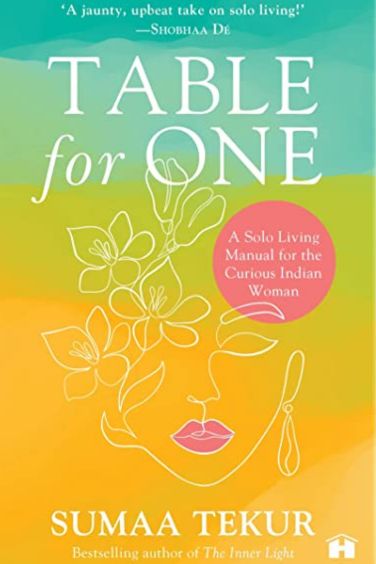
Recipe: Plant-Based Recipe – Grounding Pumpkin Soup
Groundedness, a sense of deep connection, being, or a deepening presence with others and with the universe can be felt in yoga practice, and also in combination with the foods that we eat. The unity of diet and yoga can have a deep impact on our experience. Pumpkin is one of the best foods to offer an experience of grounding. The following pumpkin soup recipe will help you to feel grounded and deepen the warmth and bond with those it is shared with.
Ingredients (for 1 serving)
- 2 cups chopped pumpkin
- 1 inch ginger
- ½ cup yellow mung (split) dal
- ½ cup walnut/almond milk (optional)
- Sea salt to taste
- Pumpkin seeds for garnishing
- Coriander leaves for garnishing
- 500-750 ml water
- 1 teaspoon ghee
Recipe:
Sauté the grated ginger in ghee until cooked. Add pumpkin, pre-soaked mung dal, water, and salt to taste, and pressure cook until soft. Blend the soup and add walnut/almond milk. Garnish the soup with pumpkin seeds and chopped coriander leaves.
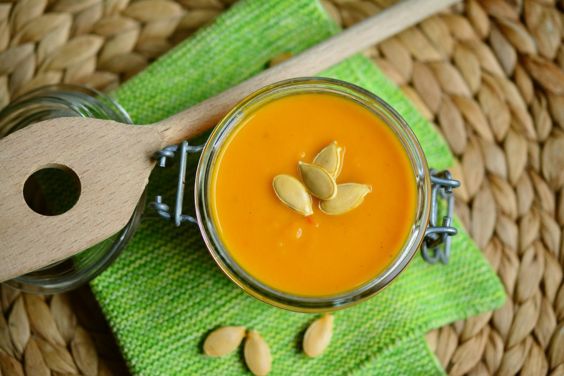
“Yoga is not to escape from home and society, but the process of moulding attitudes towards the human family with a new understanding.” -Swami Sivananda

